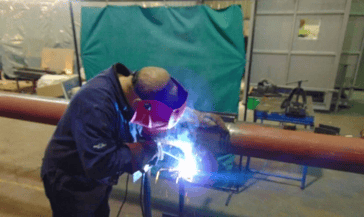Share this
Differences Between Welding And Fabrication
by Therser Sales Team on 09-May-2023 16:52:23
Welding
Welding is a process of joining two or more pieces of metal or thermoplastics together using heat and pressure. The process involves melting the materials at the point of contact and allowing them to fuse together as they cool and solidify.
Welding can be accomplished using different methods, including arc welding, gas welding, resistance welding, and laser welding. The choice of welding method depends on the type and thickness of the materials being joined, the desired strength and appearance of the weld, and the available equipment and resources.

Welding is used extensively in manufacturing, construction, and repair work. It is used to create everything from small components and structures to large buildings, bridges, ships, and pipelines. Welding is also used in the production of cars, airplanes, and other machinery, as well as in the fabrication of custom parts and prototypes.
Welding requires skill and experience to perform correctly and safely. It involves working with high temperatures, electricity, and potentially hazardous materials, and requires careful planning, preparation, and execution to ensure a strong and reliable weld.
Fabrication
Fabrication is the process of creating a finished product by cutting, shaping, and assembling raw materials, often using metal or plastic components. The goal of fabrication is to turn raw materials into a usable product, which can be anything from small parts to large structures.
The fabrication process typically involves several steps, including cutting, bending, welding, machining, and finishing. The exact process may vary depending on the materials and the specific product being fabricated. For example, in metal fabrication, raw materials are cut and shaped using saws, shears, or CNC machines, and then assembled using welding or other joining techniques.
Fabrication is used in a wide range of industries, including construction, aerospace, automotive, and manufacturing. It is used to create a variety of products, including structural components, machinery parts, and consumer goods.
Like welding, fabrication requires skill and expertise to perform effectively. Fabricators need to have a thorough understanding of the properties and characteristics of the materials they are working with, as well as the ability to use a variety of tools and techniques to shape and assemble those materials into a finished product.
In summary
Welding is a specific process for joining metal pieces together, while fabrication is a broader process that involves cutting, shaping, and assembling metal parts to create a finished product, which may or may not involve welding.
Please contact us today on 44 (0)1782 824453 or drop us an email to sales@therseruk.com
Share this
- Company News (90)
- Battery Materials (41)
- kiln (37)
- fabrication (29)
- Alloy (27)
- Furnace (27)
- Welding (16)
- Industrial Kilns (15)
- Battery (13)
- Ceramic Kilns (13)
- Processes (13)
- alloy fabrication (13)
- Shuttle Kilns (12)
- RTO’s (11)
- Vacancies (11)
- Hydrogen (10)
- Therser UK (9)
- Tunnel Kiln (9)
- Refractory (8)
- Therser (8)
- Wellman Furnaces (8)
- Brickwork (7)
- Case Studies (7)
- Afterburners (6)
- Fibre Lining (6)
- electric (6)
- Almor Wellman (5)
- thermal engineers (5)
- Biochar (4)
- Exhibition (4)
- Pyrolysis (4)
- Servicing (4)
- Spares (4)
- heat treatment (4)
- History (3)
- Ceramics Uk (2)
- Combustion Control Upgrades (2)
- Nitrogen (2)
- Temperature Control Rings (2)
- gas (2)
- Certificates (1)
- Instrumentation (1)
- MMC (1)
- RHK (1)
- Roller Hearth Kiln (1)
- Test Trials (1)
- aerospace (1)
- analyser (1)
- elec (1)
- oxygen (1)
- vans (1)
- September 2025 (2)
- May 2025 (2)
- March 2025 (1)
- February 2025 (2)
- January 2025 (5)
- December 2024 (5)
- November 2024 (7)
- October 2024 (5)
- September 2024 (4)
- August 2024 (14)
- July 2024 (13)
- June 2024 (2)
- May 2024 (5)
- April 2024 (13)
- March 2024 (8)
- February 2024 (12)
- January 2024 (14)
- December 2023 (6)
- November 2023 (12)
- October 2023 (24)
- September 2023 (11)
- August 2023 (11)
- July 2023 (9)
- June 2023 (15)
- May 2023 (53)
- April 2023 (5)
- March 2023 (6)
- February 2023 (7)
- January 2023 (3)
- December 2022 (8)
- November 2022 (5)
- October 2022 (11)
- September 2022 (1)
- August 2022 (2)
- July 2022 (1)
- June 2022 (2)
- May 2022 (1)
- March 2022 (1)
- February 2022 (1)
- January 2022 (1)
- December 2021 (3)
- October 2021 (1)
- August 2021 (1)
- June 2021 (1)
- May 2021 (4)
- April 2021 (2)
- March 2021 (4)
- February 2021 (2)
- December 2020 (3)
- November 2020 (1)
- September 2020 (3)
- May 2020 (1)
- April 2020 (2)
- March 2020 (1)
- January 2020 (1)
- December 2019 (1)
- July 2019 (2)
- June 2019 (1)
- April 2019 (2)
- March 2019 (3)
- February 2019 (4)
- December 2018 (1)
- November 2018 (1)
- September 2018 (2)
- August 2018 (1)
- July 2018 (1)
- May 2018 (3)
- April 2018 (1)
- February 2018 (3)
- January 2018 (2)
- December 2017 (3)
- November 2017 (1)
- October 2017 (2)
- September 2017 (4)
- August 2017 (1)
- July 2017 (2)
- June 2017 (2)
- May 2017 (3)
- April 2017 (3)

